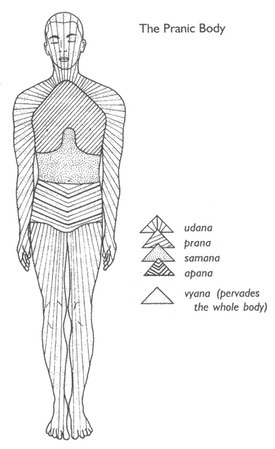Text
Pranayama the word comes by combining two words Prana and Ayama. The word Prana means Life Force and the word Ayama means dimension.
The way we experience the world around depends on the way our Prana is vibrating inside of us. If we can change the way our Prana vibrates inside of us we can change the way we notice and feel the world around.
We always feel different before and after a Yoga class. This change takes place coz in the class we do things that makes our Prana vibrate in a different way.
The practice of Asanas also influence the vibratory level of our Prana. The main practice in Yoga to influence the level of Prana inside of us is when we work with the practice of Pranayama
Below is a picture that illustrates the Panch Pranas and their general positioning in the body.
The most profound effect of Pranayama is on the mind. Controlling the mind is no easy feat. It takes tremendous persistence and patient effortto control it.
Mind can move only because of Prana. So if we need to become skillful in controlling we need to become skillful in the practice of Pranayama
Pranayama practically is a manipulation of our breathing process.
Our breathing process consists of the following 4 steps.
Pooraka (Inhalation)
Antar Kumbhaka(Holding the breath after inhaling)
Rechaka (Exhalation)
Bahir Kumbhaka(Holding the breath after exhalation)
The practice of Pranayama is using this above process of breathing in different ways.
Prana being a force it flows in different ways and different direction in the physical body and it is called as Panch Pranas. The word Panch means five.
The first among the Panch Pranas is
Prana: It operates between the larynx and the top of the diaphragm. It controls the activities and functioning of the heart and lungs and all the activities that takes place in the region of the chest such as breathing, swalloing and circulation of blood. This manifestation of Prana is experienced as light particles moving upward.
Apana: The second manifestation of Prana is Apana which is located in the region of pelvic between the navel and perinium. Apana controls the functions of the kidneys, bladder, bowels, the excretory and reproductive organs. It can be experienced as light particles moving in downward direction.
Samana: The third manifestation of Prana is Samana. The word Samana is derieved from the word Saman which means equal or balanced. It is situated between the navel and the ribcage. Between the opposite of Prana and Apana and it acts like a balance between both the opposite forces. It controls the digestive organs, digestion and assimilation of nutrients. It can be experienced as sideway movement of light like a swing of a fast pendulum.
Udana: This is the fourth dimension is Prana which is located at the extremities of the body. It is responsible for all the sensory organ and the organs of action. It controls the sympathetic and parasympathic nervous system of the body. It is experienced as a circular flow of light down the arms and legs and up through the head.
Vyana: This is the fifth manifestation of prana. This vital force pervades the whole body and acts as a reserve energy. It helps all the other pranas when they require the extra boost. It regulates muscular movements and other pranas.
Since the different regions are control by the Panch Pranas. This fact has an implication on the healing process of the body. Any region of the body that is undergoing any kind of an imbalance can be managed by the harmonizing the flow of Prana of that region and this harmonization would affect the healing process of that particular region.
